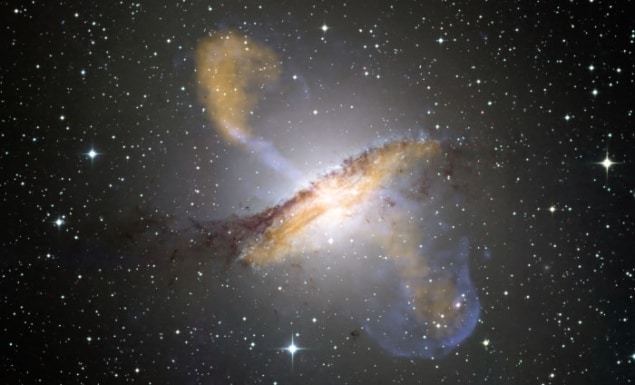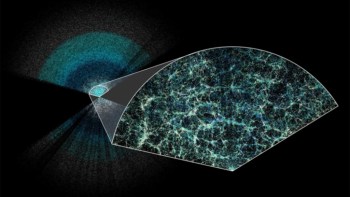
Most of the small satellite galaxies orbiting the large galaxy Centaurus A rotate in the same direction in a well-defined plane. This coordinated motion is contrary to predictions made by the cold dark matter (CDM) model of structure formation in the universe. The finding was made by an international group of astronomers and is consistent with previous observations in the Milky Way and Andromeda galaxies. The team suggests these puzzling observations should prompt astrophysicists to consider alternatives to CDM. Other astrophysicists, however, are cautious, and suspect that the results will ultimately be explained within the dark-matter paradigm.
Conventional wisdom says that a network of filaments of dark matter pervades the universe. Large galaxies form and grow as multiple dwarf galaxies are drawn in along these filaments. “The satellite [galaxies] will fall into the potential of their host galaxies from different directions,” explains team member Oliver Müller of the University of Basel in Switzerland. “They have all these different initial directions, so they will have all different orbits,” he adds. Observations, however, show that most satellite galaxies around the Milky Way, and the nearby Andromeda galaxy, orbit in step in single planes. “There were explanations saying ‘Oh, well: our local group – which consists of the Milky Way and Andromeda – is just a peculiar case,'” explains Müller.
Rich assembly
In the new research, Müller and colleagues in Germany, the US and Australia, looked at satellite galaxies in the Centaurus group. This is a rich assembly of satellite galaxies orbiting the large elliptical galaxy Centaurus A, which is 13 million light-years from Earth – about four times distant as the Andromeda galaxy. Previous research had established that the satellite galaxies lay in a single plane. To measure the motions of the satellites, the team used optical measurements from the Hubble Space Telescope to locate the position of several satellite galaxies in this plane. They then used ground-based radio astronomy measurements of specific atomic transition lines in the galaxies’ emission spectra.
Of the 16 galaxies that the researchers analysed, 14 followed a pattern whereby those on one side of Centaurus A were red shifted relative to Centaurus A, whereas those on the other side were relatively blue shifted. This suggests that the 14 were all rotating in the same direction. If the orbits had been random, the chance that 14 or more would have ended up rotating in the same direction was just 0.42%.
Simulations suggest that the apparently common occurrence of synchronized orbits among the satellite galaxies in galaxy groups could be explained if the host galaxy was formed by the collision and merger between two other galaxies. In this model, the satellite galaxies would not be leftover primordial material from the formation of the host galaxy, but rather debris thrown out by tidal interactions during the merger. Researchers have only recently begun to consider whether such a process could fit within the dark-matter model or whether an entirely new model of cosmological structure would be required, says Müller.
Perpendicular motion
“I think that their findings are interesting and extend some hints of problems that we’re seeing with other results into a new regime,” says astronomer Michael Boylan-Kolchin of the University of Texas at Austin. However, he cautions against assuming that the dark-matter model necessarily predicts the distribution of satellite galaxies would be random: “In [the dark-matter model] the structure around Centaurus A also depends on the details of the structures on much larger scales,” he explains. He suggests a useful follow-up study would be to look for motion perpendicular to the planes to find out whether the planes are stable over time: “It’s very difficult to do,” he says, “but it’s certainly possible for Andromeda with the Hubble Space Telescope”.
“It’s very puzzling, and very interesting – and it may possibly have something to say about the dark sector,” agrees astronomer Rodrigo Ibata of the Observatory of Strasbourg in France. He suggests that astronomers will still want further confirmation in other systems, but that, assuming the results hold up, he suspects a tweak to one of the underlying assumptions about galaxy formation will make the results seem less improbable. “But the whole thing may be much more interesting,” he says. “It may be that there’s something inherent about the way gravity works that we’re missing here, and on galactic scales, there’s some funky stuff that happens.”
The research is described in Science .



